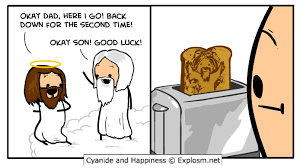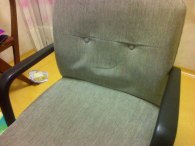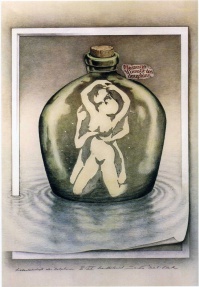In 1994, a woman called Diane Duyser was taking a bite out of her cheese toastie when she noticed a “face” looking back at her. Her grilled cheese sandwich had burn marks which supposedly formed a female expression. Duyser began promoting the grilled sandwich as resembling the Virgin Mary and it soon rose in popularity. An entire decade later the cheese toastie was auctioned off to a casino for $28,000 after more than 1.7 million people bid for it. Since this appearance of the Madonna, other famous figures have been claimed to have turned up on various foods; for example, Jesus has appeared on a marmite jar lid, a tortilla and a baking tray, Kate Middleton on a jellybean and even Hitler in a house.




There are hundreds of people who undoubtedly believe these are communications from God and have then gone on to add meaning to the food faces. Of course, countering this some atheists have taken the liberty to make jokes about the foods:


Are these sacred messages? Personally, I doubt it. But, this does raise a different question: why do people see faces in ordinary objects?
There is a physcological phenomenon called pareidolia where the mind perceives a familiar image or sound pattern in something where there is no pattern at all. Pareidolia is a type of apophenia, which is a generalized term for seeing patterns in random data.
It’s not just faces in food, pareidolia also causes people to see octopi in clothing hooks, maniacal faces in slippers, sly faces in arm chairs and happy faces in cross-sections of Marram grass blades (my favourite).




Famously, hidden messages within recorded music played in reverse or at higher- or lower-than-normal speeds arose in the media in January 1982. The hit rock song, ‘Stairway to Heaven’ by Led Zeppelin was proposed to be back masked with the line “here’s to my sweet satan”. The Trinity Broadcasting Network claimed that the message was intentional and a rebellion against the christian faith. Swan Song Records audio engineer Eddie Kramer, who produced the song, called the allegations “totally and utterly ridiculous. Why would they want to spend so much studio time doing something so dumb?”. Realistically, nobody listens to songs playing backwards and it seems a mindless, unnecessary and time-consuming way of showing support of satan. Although the audio clip of the verse beginning with “If there’s a bustle in your hedgerow, don’t be alarmed now…” played in reverse does sound convincingly like “here’s to my sweet satan”, it is presumptuous to say it is an intentional means of expressing satanic worship. Also, I have no idea how someone picked this up as I don’t know anyone who listens to songs in reverse so intently. This is most likely a case of pareidolia instead. Similarly, sightings of Big Foot, the Loch Ness monster and other theorised but rarely sighted creatures could also be due to pareidolia.
Pareidolia is actually an area of serious scientific investigation. Neuroscientists are interested in how the brain distinguishes between these real and fake faces.
We achieve distinguishing because of an area of the brain called the fusiform gyrus. This part of the brain works differently in the left hemisphere of the brain as it does in the right hemisphere. The left hemisphere fusiform gyrus initially acknowledges that what you are viewing could be a face and the right hemisphere fusiform gyrus makes the final decision. Simple enough.
However this proposes the question of why is it our instinct to see faces in random patterns. Taking something and trying to give it meaning seems unnecessary and a waste of brainpower; but, the reason is plainly survival. From earlier stages of Homo sapiens if we were out hunting and spotted something out of the corner of our eye and the left fusiform gyrus recognised it as having a possible face immediately we would be able to react and evade any possible danger. If then the right fusiform gyrus kicks-in and declares it as not being a face then there is little harm done. But the split second when the brain quickly acknowledges that there may be danger could have saved the life of the human rather than waiting for the brain to determine if the face is real or not. It is better to assume the worst (that the object is a real, living face) straight away.
However, this does not exactly explain why people claim to see so many religious figures everywhere. It is guessed that people assume that objects look like the things they are most familiar with. So people would compare this toast to the Virgin Mary before another women purely because most people can relate to the image of the Virgin Mary more easily. This also explains why children, when looking at the below painting, will see a series of dolphins instead of a couple in a graphic embrace as most adults would. This is because children are mainly not exposed to explicit images so there brains will not assume that the image is of erotic nature and instead see simple dolphins.

Facial recognition is a beautiful survival skill that has now been assimilated by robots. Facial recognition security systems on phones have become more readily available: the phone simply analyses the lines and angles of your face and determines if it is you or not in a way that is not dissimilar from the human brain. However, there are some humans who cannot carry out this somewhat basic process that so many of us have never given a thought to.
A woman called Karen Macaller cannot remember more than even one face; whereas, most humans can remember over 10,000 faces. Karen cannot recognise people so much so that she cannot tell her own two children apart. After years of believing she was just terribly forgetful with names, Karen realised she was in fact ‘face blind’. She has claimed to be able to see faces and acknowledge that everybody has different looking eyebrows and noses but the features do not come together to mean anything to her.
The technical term for Mrs Macaller’s condition is prosopagnosia and it is estimated that 2% of the population are sufferers. Prosopagnosia usually has little impact on a persons life as other ways of recognising people can be arranged (walking style, hair, voice, etc.).
There are two types of prosopagnosia: developmental and acquired. A number of NHS studies have indicated that as many as one in 50 people may have developmental prosopagnosia. Developmental prosopagnosia is thought to have a genetic component. Acquired prosopagnosia is much more rare and is usually caused by brain injury. Unlike developmental prosopagnosia people who acquire prosopagnosia quickly notice that they are suddenly unable to recognise people. Interestingly, developmental prosopagnosia has shown to have a correlation with other developmental disorders, such as autistic spectrum disorder, Turner syndrome and Williams syndrome.
Unfortunately, there is no official treatment for prosopagnosia as nobody truly knows what causes the condition. However, an under- or mis- developed fusiform gyrus is believed to be a contributing factor, although there is no absolute proof. Nonetheless, neighbouring the fusiform gyrus is an area called the parahippocampal gyrus which is responsible for colour perception and environmental orientation. Concurrently, prosopagnosia sufferers often exhibit symptoms of colour confusion and poor orienteering skills, which supports the claim that a damaged or abnormally developed area of the brain is what causes prosopagnosia.
Finally, to highlight how significant the barely acknowledged phenomenon of pareidolia is, a quote from one of the genius Leonardo da Vinci’s extensive notebooks: “if you look at any walls spotted with various stains or with a mixture of different kinds of stones, if you are about to invent some scene you will be able to see in it a resemblance to various different landscapes adorned with mountains, rivers, rocks, trees, plains, wide valleys, and various groups of hills,”. Pareidolia (or more apophenia) is everywhere and without it we may not be able to create art.